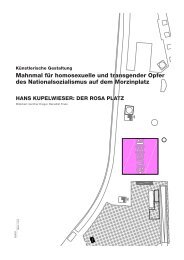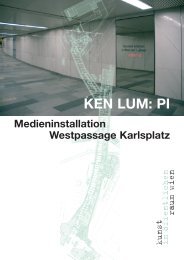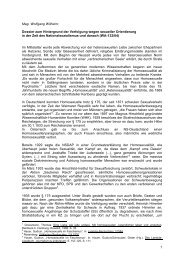KEN LUM: PI
KEN LUM: PI
KEN LUM: PI
Create successful ePaper yourself
Turn your PDF publications into a flip-book with our unique Google optimized e-Paper software.
A Sign for Karlsplatz –<br />
A Square for Art<br />
As part of a large-scale planning project, the Vienna Karlsplatz,<br />
one of the major art miles of the city, was renovated and enhanced.<br />
In the area around the Resselpark and the Rosa-<br />
Mayreder-Park at the project space karlsplatz of the Kunsthalle<br />
Vienna, open visual axes and logical paths were created to link<br />
the various art and cultural institutions and the Vienna University<br />
of Technology bordering on this area to the south.<br />
These measures were accompanied by a new lighting concept,<br />
an expansion of the cycling paths and the modernization<br />
of the entrance area to the underground passage leading<br />
from Resselpark to the Staatsoper. A crucial part of the Kunstplatz<br />
Karlsplatz project is the expansion and redesign of the<br />
Westpassage, which now leads to the immediate vicinity of<br />
the Secession and has been equipped with a staircase and<br />
elevator. The highly frequented underground passage system<br />
surrounding Vienna’s largest subway station has been complemented<br />
by a passage that now leads directly to the Naschmarkt.<br />
In keeping with architect Karl Schlauss’s idea, this passage<br />
was to remain largely free of advertisements and was to become<br />
a site where art had a significant emblematic effect. As<br />
a contribution to a further enhancement of the traffic node<br />
Karlsplatz as an attractive cultural zone, the Board of Kunst<br />
im öffentlichen Raum Wien (Art in Public Space Vienna) initiated<br />
a limited competition in 2004 for the artistic design of the<br />
Westpassage. This competition was carried out in 2005 by the<br />
Wissenschaftszentrum Wien (Vienna Science Center) in cooperation<br />
with the Wiener Linien (Vienna Transport Lines).<br />
<strong>KEN</strong> <strong>LUM</strong>: <strong>PI</strong><br />
According to the brief, the City Light show cases that are normally<br />
used for advertising purposes and are big enough for<br />
large-format posters are to serve as the main visual elements<br />
of a coherent and over-arching artistic design. There were also<br />
plans for each of the showcases to have a power supply<br />
allowing to lighting them from behind.<br />
After the jury selected the media installation Pi by the Canadian<br />
artist Ken Lum, these conditions together with the know-how<br />
of the municipal transport company Wiener Linien GmbH & Co<br />
KG rendered it possible to construct a technically elaborate<br />
artwork, driven by a computer network, in public space – an<br />
artistic concept that was seen as being unique to date.<br />
Moreover, a team experienced in art production developed,<br />
over a period of several months, the individual details together<br />
with the artist and the architect overseeing construction on<br />
site. A group of social scientists from the SORA Institute did<br />
the groundwork for the digital programming of statistic data<br />
sets which are now permanently shown on LED displays. This<br />
process initiated in a dialogue with the internationally active<br />
artist Ken Lum (who also spends a lot of time traveling) and<br />
the curators thus required a transdisciplinary communication<br />
over an extended period of time within a large, constantly growing<br />
production team. Both in this respect and on the technical<br />
level as well as in terms of the scientific work done, the<br />
media installation Pi can be seen as an extraordinary example<br />
of contemporary art production, well suited for setting standards<br />
for art in public space.<br />
kunst<br />
im öffentlichen<br />
raum wien<br />
3





